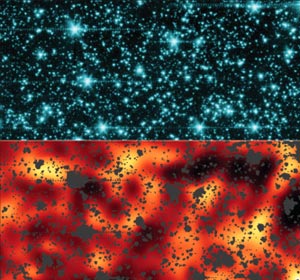Deep observations with NASA’s Spitzer Space Telescope have revealed infrared background anisotropies that can be attributed to emission from the very first stars in the universe. The diffuse glow detected by Spitzer would have been emitted more than 13 billion years ago by the first generation of stars, which are believed to have been more than a hundred times more massive than the Sun and to have lived for only a few million years before exploding as the first supernovae.

Stars of the very first generation in the universe – made only of primordial hydrogen and helium – are called Population III stars. The absence of heavy chemical elements allows them to reach masses and sizes well beyond those of the metal-rich Population I stars – like our Sun – and the older Population II stars, which are poorer in metal. These early giant stars, with masses of several hundred solar masses, have so far never been seen in galaxies observable today. Even the Hubble Ultra Deep Field has only seen galaxies with stars already enriched in heavy elements such as carbon and oxygen; and there are now doubts on the true nature and distance of the candidate Population III galaxy, which was thought to be the farthest known galaxy at a redshift of 10 (see CERN Courier May 2004 p13). It therefore seems that the detection of the very remote first stars and galaxies emerging from the “dark ages” at redshifts of about 10 to 30 will require next-generation facilities like the James Webb Space Telescope, which should replace the Hubble Space Telescope in 2013.
Now, rather unexpectedly, A Kashlinsky and collaborators claim they have already had a glimpse at those unknown territories with the modest 85 cm Spitzer Space Telescope. Removing the emission of all foreground stars and galaxies in deep infrared observations, they identified fluctuations of the background radiation on larger scales, which could be attributed to the diffuse light from the Population III era. In an article published in Nature, they discuss all other possible sources of these infrared background fluctuations: from instrumental artefacts to distant unresolved galaxies or clusters, including solar-system zodiacal light and galactic emission from interstellar clouds. They conclude that the angular size of the anisotropies is significantly different from what is expected from sources in the solar system and in our galaxy, and that their amplitude is too large to be due to unresolved faint galaxies. The fluctuations are also rather independent of the parameters used to remove foreground objects.
The relatively large amplitude (of the order of 10%) of the anisotropies could result from the fact that the era of Population III stars lasted only about 300 million years and that the very bright stars are forming at the peaks of the density field, which has been strongly amplified since the time of the cosmic microwave background emission by the gravitational pull of dark matter. A more detailed comparison of the results, with theoretical models predicting the level of fluctuations during the Population III era, will have to await forthcoming papers that are likely to be based on better results extracted from longer-exposure images. It is nevertheless exciting to think that an 85 cm telescope was able to detect the light emitted only a few hundred million years after the big bang by the very first stars lighting up the universe.
Further reading
A Kashlinsky et al. 2005 Nature 438 45.








